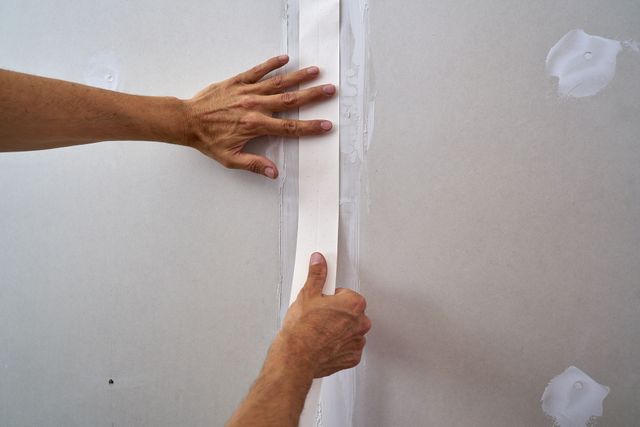Partner with experienced drywall contractors to achieve flawless results in every Interior Painting project.
Step-by-Step Approaches to Getting Flawless Drywall Repair and Setup
Attaining flawless drywall repair work and installment calls for a methodical strategy. It involves comprehending the various kinds of drywall and the tools essential for the task. Proper area prep work is essential prior to starting any job. drywall contractors. Each step, from covering holes to mounting brand-new sheets, needs interest to detail. The process does not finish with installment; ending up strategies are essential for a sleek appearance. The following steps will guarantee a seamless outcome, yet what specifically do they require?
Recognizing Drywall Types and Equipment Needed

The installation tools are similarly crucial. An utility blade is essential for cutting drywall sheets, while a drywall saw can help in making exact cuts for fixtures or outlets. T-squares guarantee precise dimensions, and drywall screws or nails protect the panels to wall surface studs. In addition, a drywall lift can facilitate the installation of large sheets, reducing physical stress. Knowledge with these kinds and devices substantially adds to the performance and high quality of drywall projects.
Preparing the Area for Repair Work or Installment
Preparing the location for drywall fixing or installment is vital to assure a efficient and smooth procedure. Initially, the surrounding room needs to be free from furnishings and various other challenges to supply sufficient working room. This not just assures safety and security however additionally stops damages to possessions. Next off, it is important to cover the flooring with ground cloth to catch any kind of particles or dust generated throughout the job.
Furthermore, the walls need to be checked for any type of loose paint or wallpaper that might disrupt adhesion. Getting rid of these aspects creates a tidy surface for the new drywall. Prior to beginning, it is advisable to transform off power to electric outlets or fixtures around. Ensuring ample illumination in the workspace will better improve visibility and emphasis during the fixing or installation procedure. drywall contractors. By thoroughly preparing the area, one lays the foundation for an effective drywall job
Step-by-Step Refine for Patching Holes

Patching holes in drywall needs a methodical strategy to guarantee a smooth repair. The initial step includes assessing the dimension of the opening. For small holes, a patching compound might be enough, while bigger openings demand a patch. Next, the broken location should be cleaned up and prepared by eliminating any type of loose debris.
For small holes, using spackling substance with a putty knife is suggested, smoothing it over the opening and feathering the edges. When completely dry, sanding the area ensures a smooth coating. For larger openings, a drywall spot should be reduced to dimension, placed over the hole, and safeguarded look at more info with screws. After installing the spot, the exact same spackling procedure is repeated, followed by fining sand.
The patched location should be primed and repainted to match the surrounding wall surface. This thorough procedure guarantees a specialist look and prolongs the lifespan of the repair.
Mounting New Drywall Sheets: A Comprehensive Overview
Installing brand-new drywall sheets needs careful preparation and implementation to ensure a durable and aesthetically attractive finish. The location must be gauged precisely to determine the number of sheets needed. It is essential to select the right density, normally 1/2-inch for interior wall surfaces and 5/8-inch for ceilings or fire-rated applications.
Next off, the studs or structure ought to be examined for any kind of irregularities, making certain they are straightened and correctly spaced. When putting the drywall sheets, they need to be positioned horizontally to lessen joints and enhance architectural honesty. A drywall lift can be beneficial for overhead installations.
Securing the sheets with drywall screws at suitable intervals ensures a safe setup. It is essential to countersink the screws somewhat listed below the surface area to plan for the finishing process. Following these guidelines will certainly bring Recommended Reading about a strong structure, ready for the next action in drywall completing.
Ending Up Touches: Insulation, Mudding, and Fining Sand Strategies
Once the drywall sheets are securely fastened, the focus shifts to the finishing touches that will give a sleek look. This process begins with taping, making use of either paper or fiberglass harmonize tape to cover the joints between sheets. The tape guarantees a smooth change, lowering the threat of fracturing. Adhering to insulation, mudding is essential; a joint substance is used over the tape to fill up spaces and produce a smooth surface area. Normally, several layers are essential, every one feathered out better than the before decrease presence.
After enough drying out time, sanding is the final action in accomplishing a perfect surface. A fine-grit sandpaper is utilized to smooth the dried substance, guaranteeing there are no flaws or bumps. Interest to detail throughout this stage is substantial, as it substantially influences the general look of the wall. Completion outcome must be an even, professional-looking surface area all set for priming and painting.
Frequently Asked Inquiries
Just how Do I Select the Right Drywall Thickness for My Project?
To pick the appropriate drywall density, click here for more consider the project's objective, area, and architectural demands. Requirement densities include 1/2-inch for basic use and 5/8-inch for fire-rated applications, ensuring longevity and conformity with structure codes.

Can I Mount Drywall Over Existing Drywall?
Yes, mounting drywall over existing drywall is possible. It is essential to assure the underlying surface area is complimentary and protected from damage. Correct attachment and factor to consider of thickness are critical for an effective setup.
What Are the very best Practices for Drywall Disposal?
The very best practices for drywall disposal include reusing when feasible, using local waste management solutions, and adhering to standards for harmful materials if appropriate. drywall contractors. Properly sealing and classifying waste guarantees conformity and safety and security during disposal
For how long Should I Wait On Mud to Dry Prior To Fining sand?
Commonly, one need to wait 1 day for drywall mud to completely dry prior to sanding. However, drying out time can differ based on moisture and temperature level, so looking for a company structure is suggested before proceeding.
Are There Eco-Friendly Drywall Options Available?
Yes, environmentally friendly drywall options are readily available. These options frequently make use of recycled products, low-VOC adhesives, and sustainable manufacturing methods, lowering ecological impact while offering efficient insulation and durability for different building and construction and renovation projects.
An utility blade is essential for reducing drywall sheets, while a drywall saw can help in making accurate cuts for components or electrical outlets. Preparing the area for drywall fixing or setup is essential to ensure a effective and smooth procedure. Patching holes in drywall calls for a systematic strategy to guarantee a smooth fixing. Setting up brand-new drywall sheets requires cautious preparation and execution to ensure a tough and visually attractive coating. Yes, installing drywall over existing drywall is possible.